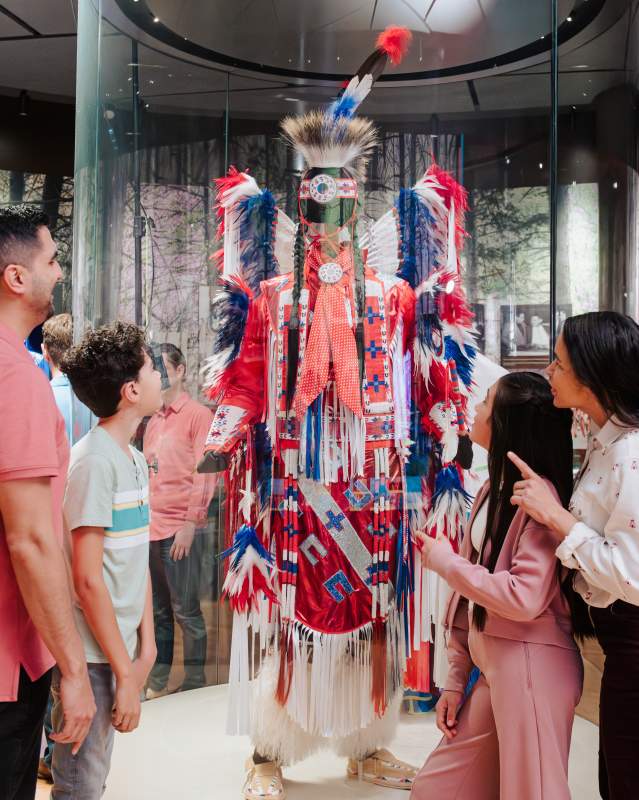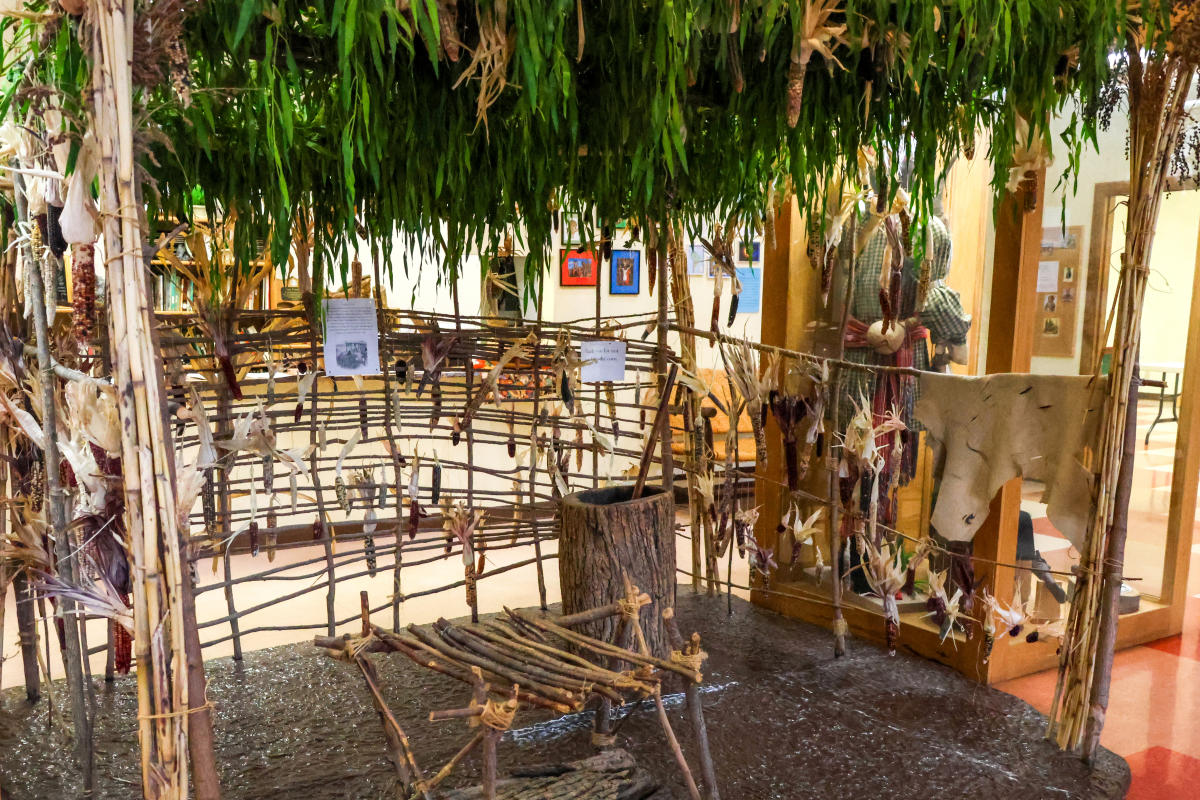
The Digital Frontier of Cultural Heritage: An In-Depth Examination of Native American Museum Visitor Guide Downloads
Native American museums and cultural centers serve as vital institutions for the preservation, interpretation, and revitalization of Indigenous cultures, histories, and contemporary experiences. Far beyond mere repositories of artifacts, these museums function as dynamic educational hubs, community gathering places, and critical platforms for decolonizing narratives and promoting Indigenous self-determination. In this evolving landscape, the accessibility and efficacy of visitor information are paramount, leading to the increasing prominence of downloadable visitor guides as sophisticated tools for enhancing engagement, fostering understanding, and ensuring cultural protocols are respected. This article will meticulously explore the multifaceted dimensions of Native American museum visitor guide downloads, adopting an educational and scholarly approach akin to an encyclopedic entry.
I. The Evolving Role of Native American Museums and the Imperative for Accessible Information
Traditionally, museums have been critiqued for their colonial origins, often presenting Indigenous cultures through an ethnographic lens that objectified people, appropriated sacred items, and perpetuated stereotypes. However, contemporary Native American museums, many of which are tribally owned and operated or have significantly empowered Indigenous voices in their governance and curatorial practices, represent a profound paradigm shift. These institutions are dedicated to:
- Cultural Affirmation and Revitalization: Actively supporting language preservation, traditional arts, and ceremonial practices.
- Decolonizing Narratives: Presenting history and culture from Indigenous epistemological frameworks, challenging dominant historical accounts.
- Education and Awareness: Informing diverse audiences about the richness and complexity of Native American societies, past and present, and addressing issues like sovereignty, treaty rights, and environmental justice.
- Repatriation and Ethical Stewardship: Leading efforts to return ancestral remains and sacred objects, aligning with the Native American Graves Protection and Repatriation Act (NAGPRA) and international ethical guidelines.
- Community Engagement: Serving as vibrant centers for tribal members, fostering intergenerational knowledge transfer and celebrating cultural continuity.

In this context, visitor guides transcend simple wayfinding. They become crucial pedagogical instruments and hermeneutic frameworks that shape a visitor’s understanding and experience. The shift towards downloadable formats represents a strategic response to the demands of modern museum pedagogy, technological advancement, and the ethical responsibilities inherent in interpreting Indigenous heritage.
II. The Purpose and Significance of Visitor Guides in Native American Museums
A visitor guide, whether physical or digital, serves several core functions within a museum environment:

- Orientation and Navigation: Providing maps, exhibit layouts, and information on amenities (restrooms, cafes, gift shops).
- Informational Content: Offering concise details about exhibits, artifacts, historical periods, and cultural concepts.
- Interpretive Enhancement: Guiding visitors through complex themes, suggesting connections between exhibits, and encouraging deeper reflection.
- Engagement and Interaction: Prompting questions, suggesting activities, or linking to supplementary resources.
For Native American museums specifically, visitor guides carry additional, profound significance:
- Cultural Contextualization: Ensuring that artifacts and stories are presented within their appropriate cultural, historical, and spiritual contexts, moving beyond mere aesthetic appreciation to a holistic understanding.
- Addressing Sensitivities: Guiding visitors on appropriate behavior, respecting cultural protocols (e.g., prohibition of photography in certain areas, handling of sacred items), and acknowledging historical trauma.
- Promoting Indigenous Voices: Featuring narratives, quotes, and perspectives directly from tribal members, elders, and cultural practitioners, ensuring authenticity and authority.
- Countering Misinformation: Proactively correcting common stereotypes and misconceptions about Native American peoples.
- Language Inclusion: Where appropriate, incorporating Indigenous languages to underscore their vitality and importance.
III. The Paradigm Shift to Downloadable Visitor Guides: Advantages and Formats
The proliferation of mobile devices and ubiquitous internet access has catalyzed a significant shift from traditional print guides to downloadable digital formats. This transition offers a myriad of advantages:
A. Key Advantages of Downloadable Guides:
- Accessibility and Pre-Visit Planning: Visitors can access guides remotely, allowing for pre-visit preparation, research, and setting informed expectations. This is particularly valuable for educators planning school trips or researchers seeking specific information.
- Sustainability and Cost-Effectiveness: Eliminates the need for extensive printing, reducing the ecological footprint and operational costs associated with material production, distribution, and disposal.
- Dynamic and Updatable Content: Digital guides can be easily updated to reflect new exhibits, research findings, cultural programming, or institutional changes, ensuring that information is always current without the need for reprinting.
- Multimedia Integration: Beyond text and static images, downloadable guides can incorporate audio (oral histories, traditional songs, expert commentary), video (documentaries, cultural demonstrations), interactive maps, 360-degree views, and even augmented reality (AR) elements, providing a richer, multi-sensory experience.
- Personalization and Customization: Advanced digital platforms can offer personalized pathways based on visitor interests, time availability, or learning styles. Multi-language support can be easily integrated, broadening reach.
- Enhanced Engagement and Interactivity: Features like quizzes, polls, feedback forms, and links to social media or deeper online archives can transform the passive viewing experience into an active, participatory one.
- Post-Visit Engagement: Guides can serve as enduring resources, allowing visitors to revisit content, explore related topics, and maintain a connection with the museum after their physical visit.
B. Common Formats for Downloadable Guides:
- PDF Documents: The simplest and most universally accessible format, offering a digital replica of a print guide. While lacking advanced interactivity, PDFs are easy to download, print, and view offline.
- Dedicated Mobile Applications (Apps): Custom-built applications offer the highest level of interactivity, multimedia integration, and user experience customization. They can include interactive maps, GPS-triggered content, curated tours, and offline functionality.
- Web-Based Mobile Guides: Optimized websites designed for mobile browsing, offering a balance between app functionality and ease of access (no download required, though content can be "saved" for offline viewing).
- Audio Tours (MP3/Streaming): Focus primarily on auditory narration, often featuring Indigenous voices, music, and soundscapes, enhancing the interpretive layer of exhibits.
IV. Key Components and Best Practices for Native American Museum Downloadable Guides
The effectiveness and ethical integrity of a downloadable guide hinge upon its content, design, and adherence to specific cultural protocols.
A. Content Accuracy and Authenticity:
- Indigenous Authorship and Consultation: Prioritize the involvement of tribal members, elders, historians, and cultural specialists in the creation and review of all content. This ensures authenticity, accuracy, and respectful representation.
- Nuanced Narratives: Avoid simplistic or monolithic portrayals of Native American cultures. Emphasize diversity, complexity, and the continuous evolution of Indigenous societies.
- Contextualization: Clearly articulate the cultural, historical, and spiritual significance of objects, artworks, and stories. Explain how items were made, used, and their role within Indigenous life.
- Contemporary Relevance: Connect historical narratives to current issues, challenges, and triumphs faced by Native American communities, demonstrating cultural continuity and resilience.
- Language: Include Indigenous language terms, names, and phrases where appropriate, with accurate pronunciation guides, to honor linguistic heritage.
B. User Experience (UX) Design:
- Intuitive Navigation: Design clear, logical pathways for accessing information, with easy-to-understand icons and menu structures.
- Mobile Optimization: Ensure guides are fully responsive and functional across various mobile devices (smartphones, tablets) and operating systems.
- Accessibility Features: Incorporate features for visitors with disabilities, such as screen reader compatibility, adjustable font sizes, high-contrast modes, and closed captions for video content.
- Offline Access: Provide options for downloading content for offline use, acknowledging potential connectivity issues within the museum or remote areas.
- Visual Appeal: Utilize high-quality images, maps, and design elements that are aesthetically pleasing and culturally appropriate.
C. Educational Depth and Interpretive Richness:
- Layered Information: Offer different levels of detail, allowing visitors to delve deeper into topics of interest or gain a quick overview.
- Critical Thinking Prompts: Include questions or prompts that encourage visitors to reflect on the information, challenge assumptions, and consider different perspectives.
- Connections to Broader Themes: Link specific exhibits to larger themes of Indigenous sovereignty, environmental stewardship, artistic expression, or social justice.
- Resources for Further Learning: Provide links to external resources, bibliographies, or related online content for those wishing to expand their knowledge.
D. Ethical Considerations and Cultural Protocols:
- Respect for Sacred Knowledge: Clearly identify and respect restrictions on sharing certain sacred or sensitive information, images, or stories. Some content may be for specific audiences only or not for public dissemination.
- Intellectual Property Rights: Ensure that all content (text, images, audio, video) respects the intellectual property rights of Indigenous communities and individuals, with proper attribution and permissions.
- Avoidance of Harmful Imagery: Be sensitive to images or historical accounts that may evoke trauma or perpetuate harmful stereotypes.
- Data Privacy: Clearly communicate policies regarding user data collection and privacy, especially for interactive apps.
V. Challenges and Future Directions
While highly advantageous, downloadable guides present certain challenges:
- Digital Divide: Not all visitors have access to smartphones, reliable internet, or the technological literacy required to utilize digital guides effectively. Museums must consider hybrid solutions (physical guides, loaner devices) to ensure equity.
- Development and Maintenance Costs: Creating sophisticated apps with rich multimedia content can be expensive and requires ongoing technical maintenance and content updates.
- Technological Obsolescence: Digital platforms and file formats evolve rapidly, necessitating periodic upgrades or redesigns.
- Ensuring Human Connection: Digital guides should augment, not replace, the valuable role of museum staff, educators, and Indigenous cultural interpreters.
Looking forward, the future of Native American museum downloadable guides is likely to embrace:
- Enhanced Personalization through AI: Using artificial intelligence to tailor content suggestions based on visitor profiles and in-museum behavior.
- Augmented Reality (AR) and Virtual Reality (VR): Creating immersive experiences that bring cultural sites, historical events, or traditional practices to life within the museum or even remotely.
- Greater Integration of Indigenous Languages: Developing comprehensive multi-lingual guides that prioritize and revitalize Indigenous languages.
- Community-Generated Content: Empowering tribal members to contribute directly to the guide’s content through user-friendly interfaces, fostering a sense of ownership and living heritage.
- Seamless Integration with Online Collections: Linking exhibit content directly to the museum’s digital collections database for deeper exploration.
VI. Conclusion
Downloadable visitor guides are indispensable tools in the contemporary Native American museum landscape. They are not merely digital versions of printed brochures but represent dynamic, multimedia platforms that significantly enhance the visitor experience, deepen understanding, and uphold the ethical responsibilities inherent in cultural stewardship. By prioritizing Indigenous voices, ensuring content accuracy and cultural sensitivity, and leveraging advanced digital technologies, these guides play a crucial role in decolonizing museum spaces, fostering respectful engagement, and ensuring that the rich and vibrant narratives of Native American peoples resonate powerfully with audiences worldwide. Their continued evolution will be vital in advancing the missions of these pivotal institutions in the 21st century and beyond.


